Preliminary Investigation of the Remnants of Low-Latitude Glacial Activity on the Southeastern Margin of the Qinghai–Tibet Plateau
Abstract
:1. Introduction
- (1)
- To establish the presence of Quaternary glacial activity in the Liangwang Mountains;
- (2)
- To determine the environmental conditions that facilitated glacier formation in this region;
- (3)
- To explore the factors contributing to glacial development in the Liangwang Mountains, considering its unique low-latitude location.
2. Materials and Methods
2.1. Study Area
2.2. Field Survey and Topographic Analysis
2.3. Scanning Electron Microscope Analysis of Quartz Sand
2.4. Sporopollen Analysis
3. Results
3.1. Geomorphological Features of the Glacier in the Liangwang Mountains
3.2. Characterization of the Quartz Particle Morphology
3.3. Palynological Characterization
4. Discussion
4.1. Ice Age Discussion
4.2. Why Did Glaciers Develop in the Liangwang Mountains?
5. Conclusions
Author Contributions
Funding
Institutional Review Board Statement
Informed Consent Statement
Data Availability Statement
Acknowledgments
Conflicts of Interest
References
- Brook, E.J.; Buizert, C. Antarctic and global climate history viewed from ice cores. Nature 2018, 558, 200–208. [Google Scholar] [CrossRef] [PubMed]
- Herbert, T.D. The Mid-Pleistocene Climate Transition. Annu. Rev. Earth Planet. Sci. 2023, 51, 389–418. [Google Scholar] [CrossRef]
- Eaves, S.R.; Winckler, G.; Mackintosh, A.N.; Schaefer, J.M.; Townsend, D.B.; Doughty, A.M.; Jones, R.S.; Leonard, G.S. Late-glacial and Holocene glacier fluctuations in north island, New Zealand. Quat. Sci. Rev. 2019, 223, 105914. [Google Scholar] [CrossRef]
- Lešić, N.-M.; Streuff, K.T.; Bohrmann, G.; Kuhn, G. Glacimarine sediments from outer Drygalski Trough, sub-Antarctic South Georgia–evidence for extensive glaciation during the Last Glacial Maximum. Quat. Sci. Rev. 2022, 292, 107657. [Google Scholar] [CrossRef]
- Bolch, T.; Kulkarni, A.; Kääb, A.; Huggel, C.; Paul, F.; Cogley, J.G.; Frey, H.; Kargel, J.S.; Fujita, K.; Scheel, M. The state and fate of Himalayan glaciers. Science 2012, 336, 310–314. [Google Scholar] [CrossRef]
- Shan, Z.; Li, Z.; Dong, X. Impact of glacier changes in the Himalayan Plateau disaster. Ecol. Inform. 2021, 63, 101316. [Google Scholar] [CrossRef]
- Ehlers, T.A.; Chen, D.; Appel, E.; Bolch, T.; Chen, F.; Diekmann, B.; Dippold, M.A.; Giese, M.; Guggenberger, G.; Lai, H.-W. Past, present, and future geo-biosphere interactions on the Tibetan Plateau and implications for permafrost. Earth-Sci. Rev. 2022, 234, 104197. [Google Scholar] [CrossRef]
- Lehmkuhl, F.; Owen, L.A. Late Quaternary glaciation of Tibet and the bordering mountains: A review. Boreas 2005, 34, 87–100. [Google Scholar] [CrossRef]
- Owen, L.A.; Finkel, R.C.; Barnard, P.L.; Haizhou, M.; Asahi, K.; Caffee, M.W.; Derbyshire, E. Climatic and topographic controls on the style and timing of Late Quaternary glaciation throughout Tibet and the Himalaya defined by 10Be cosmogenic radionuclide surface exposure dating. Quat. Sci. Rev. 2005, 24, 1391–1411. [Google Scholar] [CrossRef]
- Zhou, S.; Xu, L.; Colgan, P.M.; Mickelson, D.M.; Wang, X.; Wang, J.; Zhong, W. Cosmogenic 10Be dating of Guxiang and Baiyu glaciations. Chin. Sci. Bull. 2007, 52, 1387–1393. [Google Scholar] [CrossRef]
- Thompson, L.o.; Yao, T.; Davis, M.; Henderson, K.; Mosley-Thompson, E.; Lin, P.-N.; Beer, J.; Synal, H.-A.; Cole-Dai, J.; Bolzan, J. Tropical climate instability: The last glacial cycle from a Qinghai-Tibetan ice core. Science 1997, 276, 1821–1825. [Google Scholar] [CrossRef]
- Chen, R.; Zhou, S.; Li, Y.; Lai, Z.; Ou, X.; Lu, X.; Li, Y. Late Quaternary climate and environmental change derived from glacial deposits in the Parlung Zangbo Valley, southeastern Tibetan Plateau. Phys. Geogr. 2020, 41, 99–125. [Google Scholar] [CrossRef]
- Li, K.; Liu, X.; Herzschuh, U.; Wang, Y. Rapid climate fluctuations over the past millennium: Evidence from a lacustrine record of Basomtso Lake, southeastern Tibetan Plateau. Sci. Rep. 2016, 6, 24806. [Google Scholar] [CrossRef]
- Wang, X.; Chai, K.; Liu, S.; Wei, J.; Jiang, Z.; Liu, Q. Changes of glaciers and glacial lakes implying corridor-barrier effects and climate change in the Hengduan Shan, southeastern Tibetan Plateau. J. Glaciol. 2017, 63, 535–542. [Google Scholar] [CrossRef]
- Chen, R.; Zhou, S.; Lai, Z.; Ou, X.; Chen, R.; Deng, Y. Luminescence chronology of late Quaternary moraines and Last Glacial Maximum equilibrium-line altitude reconstruction from Parlung Zangbo Valley, south-eastern Tibetan Plateau. J. Quat. Sci. 2014, 29, 597–604. [Google Scholar] [CrossRef]
- Chen, Y.; Li, Y.; Zhang, M.; Cui, Z.; Liu, G. Much late onset of Quaternary glaciations on the Tibetan Plateau: Determining the age of the Shishapangma Glaciation using cosmogenic 26Al and 10Be dating. Sci. Bull. 2018, 63, 306–313. [Google Scholar] [CrossRef]
- Zheng, B.; Xu, Q.; Shen, Y. The relationship between climate change and Quaternary glacial cycles on the Qinghai–Tibetan Plateau: Review and speculation. Quat. Int. 2002, 97, 93–101. [Google Scholar] [CrossRef]
- Wang, M.; Wang, X.; Pan, B.; Yi, S.; Van Balen, R.; Zhao, Z.; Dong, X.; Vandenberghe, J.; Wang, Y.; Lu, H. Multiple paleolakes caused by glacier river-blocking on the southeastern Tibetan plateau in response to climate changes since the last glacial maximum. Quat. Sci. Rev. 2023, 305, 108012. [Google Scholar] [CrossRef]
- Yang, J.; Zhang, W.; Cui, Z.; Yi, C.; Liu, K.; Ju, Y.; Zhang, X. Late Pleistocene glaciation of the Diancang and Gongwang Mountains, southeast margin of the Tibetan Plateau. Quat. Int. 2006, 154, 52–62. [Google Scholar] [CrossRef]
- Zhang, W.; Chai, L.; Evans, I.S.; Liu, L.; Li, Y.-P.; Qiao, J.-R.; Tang, Q.-Y.; Sun, B. Geomorphic features of Quaternary glaciation in the Taniantaweng Mountain, on the southeastern Qinghai-Tibet Plateau. J. Mt. Sci. 2019, 16, 256–274. [Google Scholar] [CrossRef]
- Ruiz-Fernández, J.; Oliva, M.; Hughes, P. Permafrost and periglacial processes in mid-and low-latitude mountain regions. Permafr. Periglac. Process. 2019, 30, 245–248. [Google Scholar] [CrossRef]
- Chandler, B.M.; Lovell, H.; Boston, C.M.; Lukas, S.; Barr, I.D.; Benediktsson, Í.Ö.; Benn, D.I.; Clark, C.D.; Darvill, C.M.; Evans, D.J. Glacial geomorphological mapping: A review of approaches and frameworks for best practice. Earth-Sci. Rev. 2018, 185, 806–846. [Google Scholar] [CrossRef]
- Chmielowska, D.; Woronko, B.; Dorocki, S. Applicability of automatic image analysis in quartz-grain shape discrimination for sedimentary setting reconstruction. CATENA 2021, 207, 105602. [Google Scholar] [CrossRef]
- Itamiya, H.; Sugita, R.; Sugai, T. Analysis of the surface microtextures and morphologies of beach quartz grains in Japan and implications for provenance research. Prog. Earth Planet. Sci. 2019, 6, 43. [Google Scholar] [CrossRef]
- Vos, K.; Vandenberghe, N.; Elsen, J. Surface textural analysis of quartz grains by scanning electron microscopy (SEM): From sample preparation to environmental interpretation. Earth-Sci. Rev. 2014, 128, 93–104. [Google Scholar] [CrossRef]
- Woronko, B.; Dłużewski, M.; Woronko, D. Sand-grain micromorphology used as a sediment-source indicator for Kharga Depression dunes (Western Desert, S Egypt). Aeolian Res. 2017, 29, 42–54. [Google Scholar] [CrossRef]
- Woronko, B. Frost weathering versus glacial grinding in the micromorphology of quartz sand grains: Processes and geological implications. Sediment. Geol. 2016, 335, 103–119. [Google Scholar] [CrossRef]
- Chmielowska, D.; Woronko, B. A source of loess-like deposits and their attendant palaeoenvironment–Orava Basin, Western Carpathian Mountains, S Poland. Aeolian Res. 2019, 38, 60–76. [Google Scholar] [CrossRef]
- Kalińska, E.; Lamsters, K.; Karušs, J.; Krievāns, M.; Rečs, A.; Ješkins, J. Does glacial environment produce glacial mineral grains? Pro-and supra-glacial Icelandic sediments in microtextural study. Quat. Int. 2022, 617, 101–111. [Google Scholar] [CrossRef]
- Wang, W.-X.; Zhao, X.-L.; Li, S.-J.; Zhang, L.; Wang, X.-L.; Zhang, X.-Y. Palynoflora and climatic dynamics of the Laizhou Bay of Bohai Sea, North China Plain, since the late middle Pleistocene. J. Palaeogeogr. 2023, 12, 278–295. [Google Scholar] [CrossRef]
- Wu, F.; Miao, Y.; Meng, Q.; Fang, X.; Sun, J. Late Oligocene Tibetan Plateau warming and humidity: Evidence from a sporopollen record. Geochem. Geophys. Geosyst. 2019, 20, 434–441. [Google Scholar] [CrossRef]
- Ohmura, A.; Kasser, P.; Funk, M. Climate at the equilibrium line of glaciers. J. Glaciol. 1992, 38, 397–411. [Google Scholar] [CrossRef]
- Shi, Y. Glaciations and Environmental Variations in East China; Science Press: Beijing, China, 1989. [Google Scholar]
- Zhang, W.; Li, Y.; Liu, B. Development and Cause of Glacial since Middle Pleistocene in Low Latitude of China. Geogr. Geo-Inf. Sci. 2013, 29, 78–83. [Google Scholar]
- Kuang, M.; Li, J.; Zhao, Y. Quaternary glacial remains in Gongwang Mountain, Northeastern Yunnan Province. J. Glaciol. Geocryol. 1997, 19, 78–84. [Google Scholar]
- Zhang, W.; Cui, Z.; Feng, J.; Yi, C.; Yang, J. Late Pleistocene glaciation of the Hulifang massif of Gongwang mountains in Yunnan Province. J. Geogr. Sci. 2005, 15, 448–458. [Google Scholar] [CrossRef]
- Wang, L.; Chen, R.; Song, Y.; Yang, Y.; Liu, J.; Han, C.; Liu, Z. Precipitation–altitude relationships on different timescales and at different precipitation magnitudes in the Qilian Mountains. Theor. Appl. Climatol. 2018, 134, 875–884. [Google Scholar] [CrossRef]
- Fu, P.; Stroeven, A.P.; Harbor, J.M.; Hättestrand, C.; Heyman, J.; Caffee, M.W.; Zhou, L. Paleoglaciation of Shaluli Shan, southeastern tibetan plateau. Quat. Sci. Rev. 2013, 64, 121–135. [Google Scholar] [CrossRef]
- Zhao, Y.; Tzedakis, P.C.; Li, Q.; Qin, F.; Cui, Q.; Liang, C.; Birks, H.J.B.; Liu, Y.; Zhang, Z.; Ge, J. Evolution of vegetation and climate variability on the Tibetan Plateau over the past 1.74 million years. Sci. Adv. 2020, 6, eaay6193. [Google Scholar] [CrossRef] [PubMed]
- Tong, G.; Bai, T.; Zhou, S. Fluctuating characteristics of Quaternary sporulation time series in the Kunming Basin and their geoenvironmental significance. J. Integr. Plant Biol. 1990, 32, 146–156. [Google Scholar]
- Xu, L.; Zhou, S. Quaternary glaciations recorded by glacial and fluvial landforms in the Shaluli Mountains, Southeastern Tibetan Plateau. Geomorphology 2009, 103, 268–275. [Google Scholar] [CrossRef]
- Zhang, Q.; Yi, C.; Dong, G.; Fu, P.; Wang, N.; Capolongo, D. Quaternary glaciations in the lopu kangri area, central Gangdise mountains, southern Tibetan plateau. Quat. Sci. Rev. 2018, 201, 470–482. [Google Scholar] [CrossRef]
- He, J.; Wang, J.; Zheng, C.; Li, W.; Sun, W.; Guo, T.; Zeng, S. Geochemical characteristics of lake clay drilled in well QZ-4: Its implication for geochemical response to climate change in the central Tibetan Plateau in the Middle–Late Pleistocene. Environ. Earth Sci. 2016, 75, 1312. [Google Scholar] [CrossRef]
- Zhang, W.; Liu, L.; Chai, L.; He, D. Characteristics of quaternary glaciations suing ESR daring method in the luoji mountain, sichuan province. Quat. Sci. 2017, 37, 281–292. [Google Scholar]
- Chen, A.; Zheng, M.; Shi, L.; Wang, H.; Xu, J. Magnetostratigraphy of deep drilling core 15YZK01 in the northwestern Qaidam Basin (NE Tibetan Plateau): Tectonic movement, salt deposits and their link to Quaternary glaciation. Quat. Int. 2017, 436, 201–211. [Google Scholar] [CrossRef]
- Liu, X.; Xu, Q.; Ding, L. Differential surface uplift: Cenozoic paleoelevation history of the Tibetan Plateau. Sci. China Earth Sci. 2016, 59, 2105–2120. [Google Scholar] [CrossRef]
- Xiang, F.; Huang, H.; Ogg, J.G.; Zhu, H.; Kang, D. Quaternary sediment characteristics and paleoclimate implications of deposits in the Three Gorges and Yichang areas of the Yangtze River. Geomorphology 2020, 351, 106981. [Google Scholar] [CrossRef]
- Shi, X.-h.; Wang, E.; Wang, G.; Fan, C. Late cenozoic uplift of the yulong snow mountain (5596 m), se tibetan plateau, caused by erosion and tectonic forcing. Quat Sci 2008, 28, 222–231. [Google Scholar]
- Li, B.-L.; Ji, J.-Q.; Lo, C.-H.; Gong, J.-F.; Qing, J.-C. The structural style and timing of uplift of the Ailaoshan-Diancang Range, West Yunnan, China. Dizhen Dizhi 2012, 34, 696–712. [Google Scholar]
- Wang, J.; Raisbeck, G.; Xu, X.; Yiou, F.; Bai, S. In situ cosmogenic 10Be dating of the Quaternary glaciations in the southern Shaluli Mountain on the Southeastern Tibetan Plateau. Sci. China Ser. D Earth Sci. 2006, 49, 1291–1298. [Google Scholar] [CrossRef]
- Riechers, K.; Mitsui, T.; Boers, N.; Ghil, M. Orbital insolation variations, intrinsic climate variability, and Quaternary glaciations. Clim. Past 2022, 18, 863–893. [Google Scholar] [CrossRef]
- Martynov, A.; Sushama, L.; Laprise, R.; Winger, K.; Dugas, B. Interactive lakes in the Canadian Regional Climate Model, version 5: The role of lakes in the regional climate of North America. Tellus A Dyn. Meteorol. Oceanogr. 2012, 64, 16226. [Google Scholar] [CrossRef]
- Zhu, L.; Jin, J.; Liu, X.; Tian, L.; Zhang, Q. Simulations of the impact of lakes on local and regional climate over the Tibetan Plateau. Atmosphere-Ocean 2018, 56, 230–239. [Google Scholar] [CrossRef]
- Dai, Y.; Yao, T.; Wang, L.; Li, X.; Zhang, X. Contrasting roles of a large alpine lake on tibetan plateau in shaping regional precipitation during summer and autumn. Front. Earth Sci. 2020, 8, 358. [Google Scholar] [CrossRef]
- Specht, N.F.; Claussen, M.; Kleinen, T. Dynamic interaction of lakes, climate and vegetation over northern Africa during the mid-Holocene. EGUsphere 2024, 2024, 1–27. [Google Scholar]

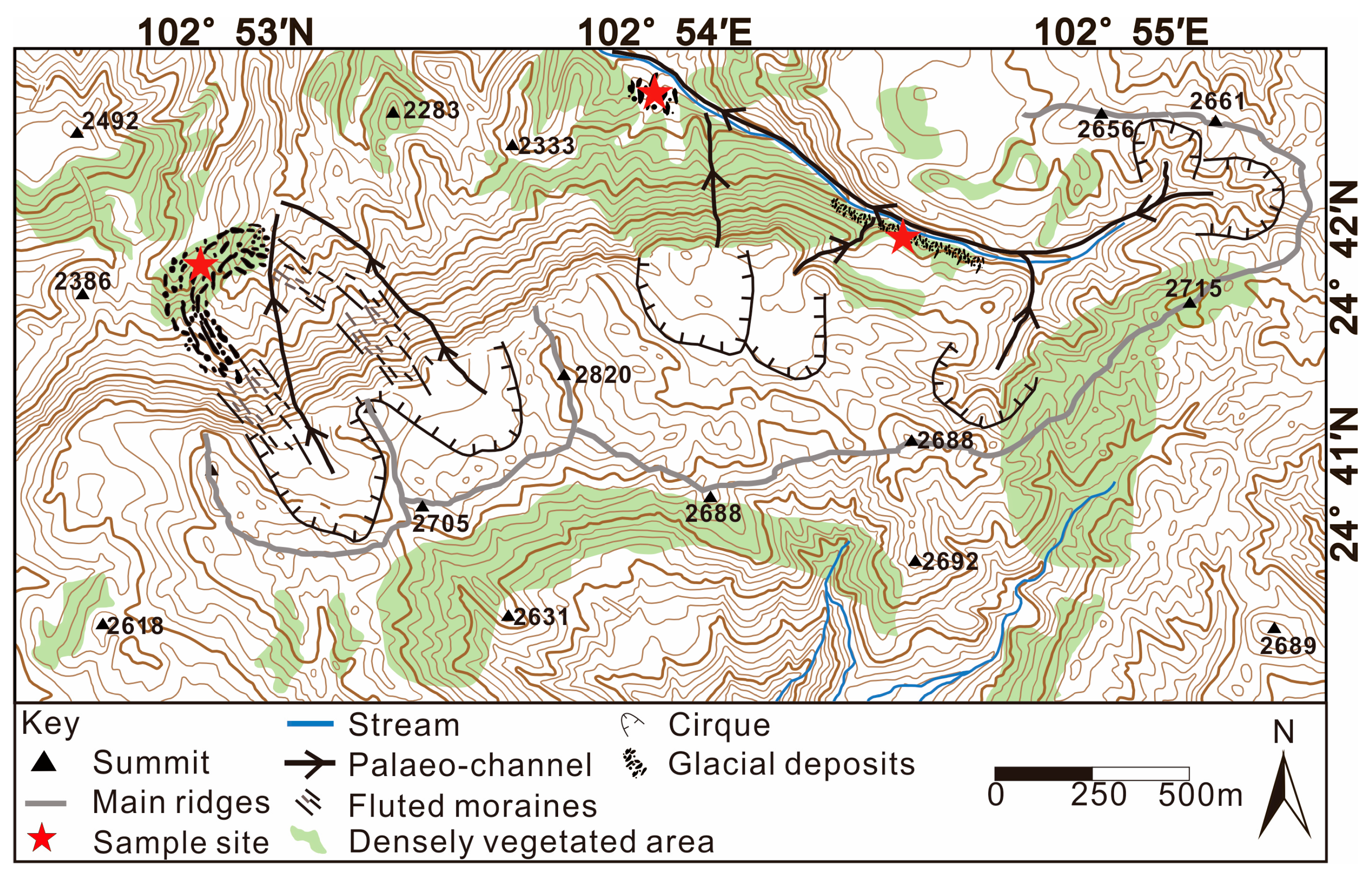

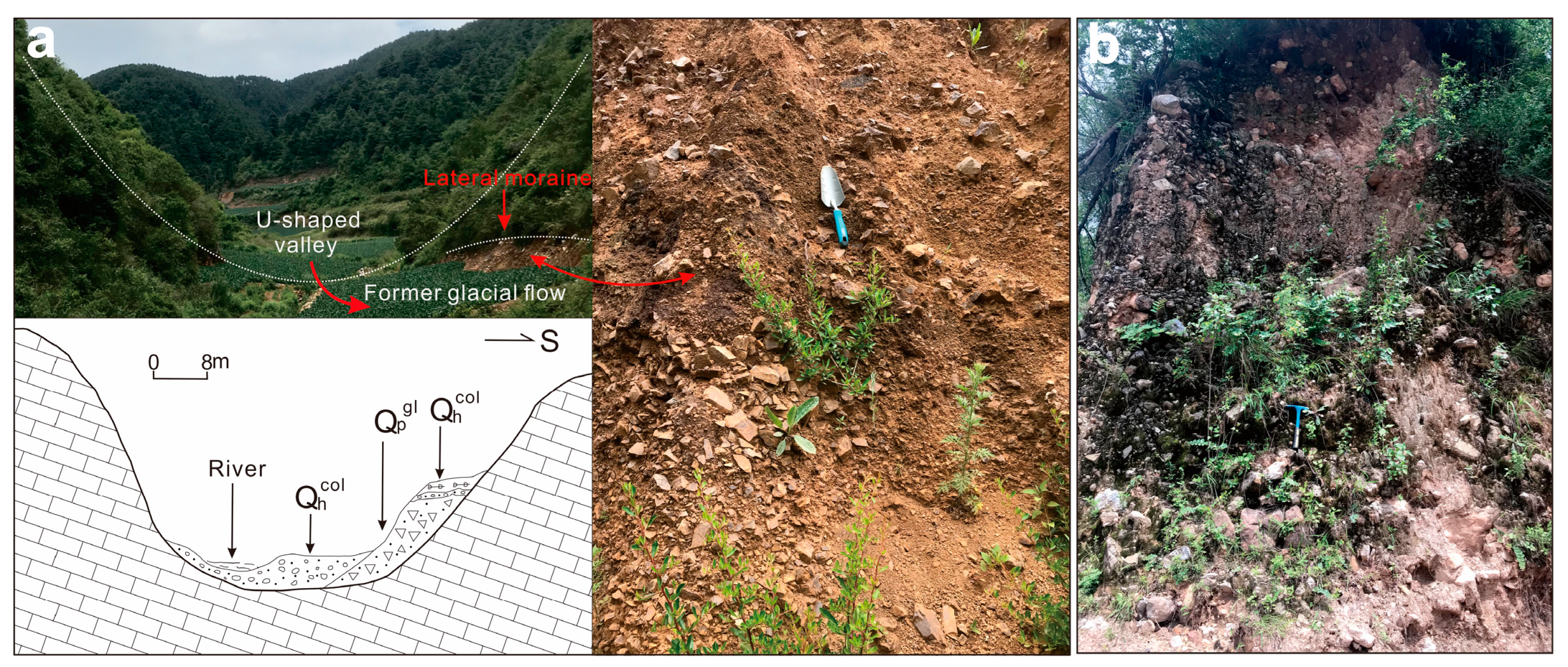
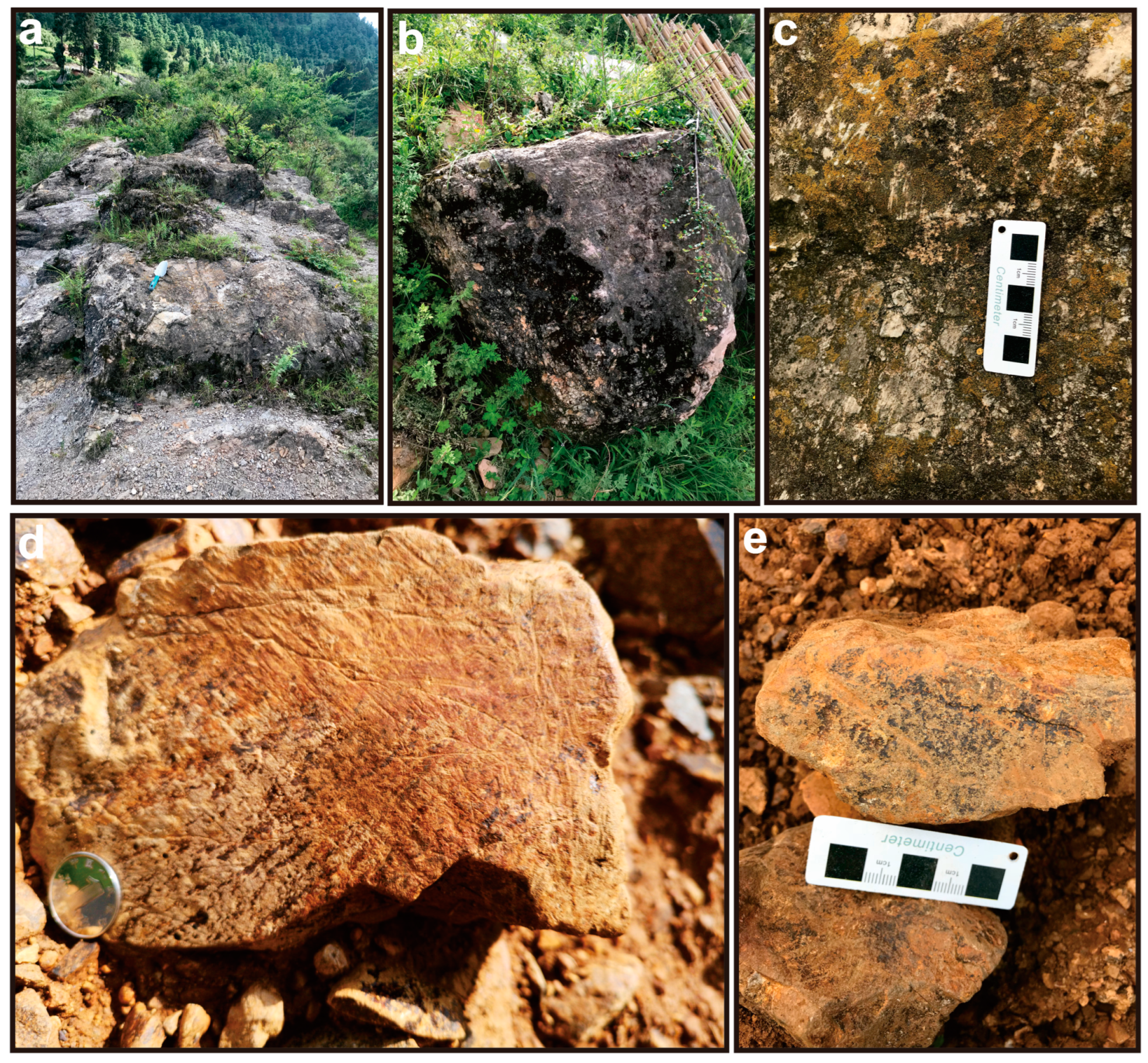
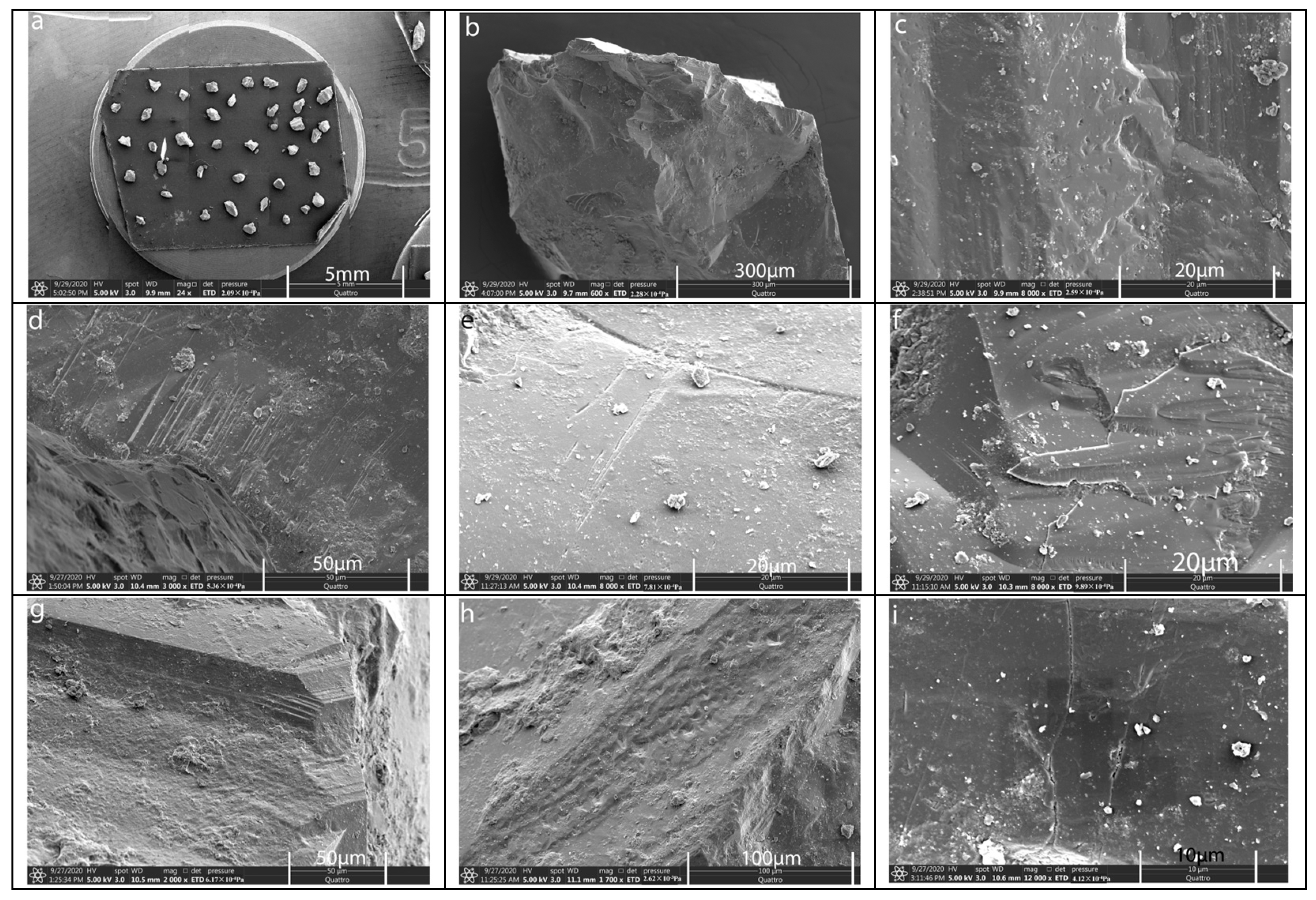



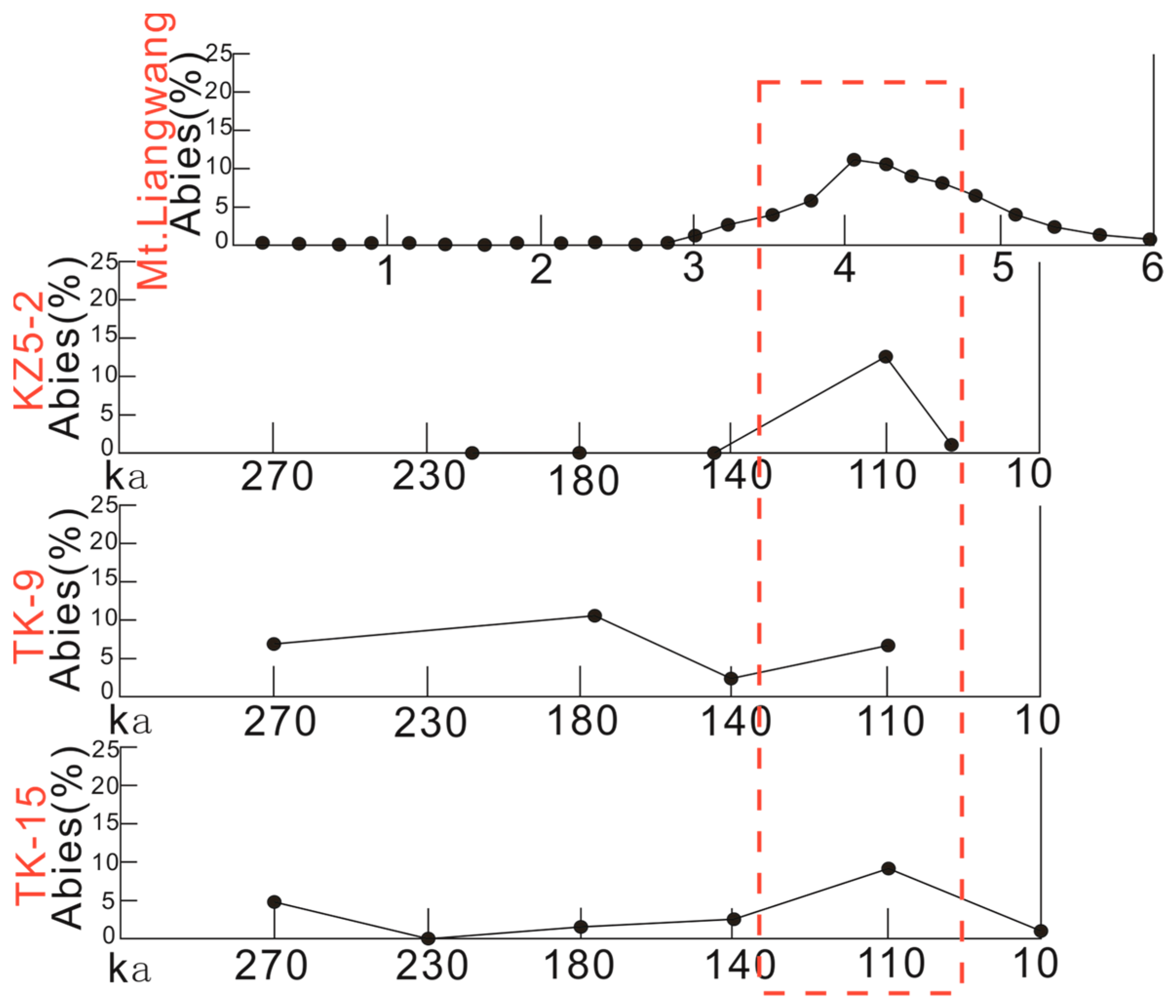

| Shape of quartz sand | Roundedness | 13: well-rounded; 14: round; 18: subrounded; 25: subangular; 34: multangular; 35: pointed | ||
| Edge shape | 15: abraded edge; 17: subrounded edge; 24: subangular ridge; 32: ridge erosion; 33: sharp-edged ridge | |||
| Relief | 16: low relief; | 23: moderate relief; | 31: high relief | |
| Mechanical | 10: sinuous ridge; 11: folded cleavage planes; 12: dish-shaped pits; 19: subaqueous polish; 20: small impact crater; 21: straight grooves; 22: V-shaped gouges; 26: small shell-shaped fragments; 27: adhering fragments; 28: fractures; 29: parallel striations; 30: deep impact crater; 36: terraces; 37: parallel cleavage planes; 38: medium-sized shell-shaped fractures; 39: large shell-shaped fractures | |||
| Chemical | 1: flakey exfoliation; 2: silica crystallization; 3: amorphous silica precipitation; 4: siliceous film; 5: siliceous scales; 6: siliceous sphere; 7: honeycomb etching surface; 8: oriented etch pits; 9: pits and grooves | |||
| Method | MPC | MPF | WPF | ||||
|---|---|---|---|---|---|---|---|
| Mountain Range | Height of Weather Station (m) | Weather Station June to August Temperature (°C) | Average Annual Precipitation at Meteorological Stations (mm) | Actual Equilibrium Line Height (m) | Theoretical Equilibrium Line Height (m) | Theoretical Equilibrium Line Height (m) | Theoretical Equilibrium Line Height (m) |
| Altai | 1900 | 11.9 | 664 | 3320 | 3688 | 3750 | 3873 |
| Tianshan | 3539 | 4.3 | 454 | 4056 | 4239 | 4294 | 4365 |
| Baima | 4292 | 5.1 | 807.1 | 4800 | 4867 | 4942 | 5054 |
| Yulong | 2393 | 17.7 | 950 | 4800 | 5026 | 5076 | 5176 |
| Luoji | 2640 | 15.8 | 956 | 4940 | 5005 | 5103 | |
| Qianhu | 3276 | 12.9 | 849.8 | 5134 | 5206 | 5312 | |
| Cangshan | 1990 | 19.8 | 1054 | 4905 | 4980 | 5068 | |
| Gongwang | 3900 | 6.8 | 1570 | 4488 | 4558 | 4553 | |
| Yushan | 3845 | 7.4 | 3054 | 4361 | 4328 | 3953 | |
| Liangwang | 1906 | 16.1 | 1100 | 4256 | 4262 | 4341 |
Disclaimer/Publisher’s Note: The statements, opinions and data contained in all publications are solely those of the individual author(s) and contributor(s) and not of MDPI and/or the editor(s). MDPI and/or the editor(s) disclaim responsibility for any injury to people or property resulting from any ideas, methods, instructions or products referred to in the content. |
© 2024 by the authors. Licensee MDPI, Basel, Switzerland. This article is an open access article distributed under the terms and conditions of the Creative Commons Attribution (CC BY) license (https://creativecommons.org/licenses/by/4.0/).
Share and Cite
Pan, Y.; Zhang, S.; Chen, J.; Zhang, C.; Wu, S. Preliminary Investigation of the Remnants of Low-Latitude Glacial Activity on the Southeastern Margin of the Qinghai–Tibet Plateau. Sustainability 2024, 16, 3492. https://doi.org/10.3390/su16083492
Pan Y, Zhang S, Chen J, Zhang C, Wu S. Preliminary Investigation of the Remnants of Low-Latitude Glacial Activity on the Southeastern Margin of the Qinghai–Tibet Plateau. Sustainability. 2024; 16(8):3492. https://doi.org/10.3390/su16083492
Chicago/Turabian StylePan, Yiwen, Shitao Zhang, Jianping Chen, Cheng Zhang, and Shuangshuang Wu. 2024. "Preliminary Investigation of the Remnants of Low-Latitude Glacial Activity on the Southeastern Margin of the Qinghai–Tibet Plateau" Sustainability 16, no. 8: 3492. https://doi.org/10.3390/su16083492




